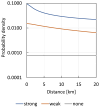Spatially explicit estimation of recent migration rates in plants using genotypic data
- PMID: 39873156
- PMCID: PMC11796463
- DOI: 10.1093/genetics/iyae218
Spatially explicit estimation of recent migration rates in plants using genotypic data
Abstract
We present a new hierarchical Bayesian method using multilocus genotypes to estimate recent seed and pollen migration rates in a spatially explicit framework that incorporates distance effects separately for each type of dispersal. The method additionally estimates population allelic frequencies, population divergence values, individual inbreeding coefficients, individual maternal and paternal ancestries, and allelic dropout rates. We conduct a numerical simulation analysis that indicates that the method can provide reliable estimates of seed and pollen migration rates and allow accurate inference of spatial effects on migration, at affordable sample sizes (25-50 individuals/population) when population genetic divergence is not low (FST≥0.05), or by increasing sampling (to at least 100 individuals/population) under weaker levels of divergence (FST=0.025). Simulations also show that the accuracy provided by assays with about one thousand unlinked polymorphic SNP loci may approach, for a given sample size, the theoretical maximum achievable under categorical origin discrimination. We apply our method to Taxus baccata data, revealing low but significant seed and pollen migration among nearby population remnants during the last generation, with a negative effect of interpopulation distance on migration that was detectable for pollen but not for seeds.
Keywords: Taxus baccata; gene flow; isolation by distance; seed and pollen dispersal; zygotic and gametic migration.
© The Author(s) 2025. Published by Oxford University Press on behalf of The Genetics Society of America.
Conflict of interest statement
Conflicts of interest: The authors declare no conflicts of interest.
Figures




References
MeSH terms
Grants and funding
LinkOut - more resources
Full Text Sources
Miscellaneous

